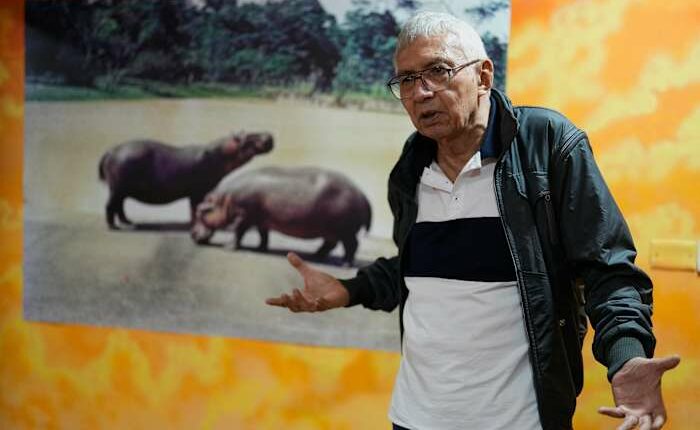Share this @internewscast.com

BOGOTA – In a room filled with art, Colombian photographer Édgar Jiménez surveys his work, “Adam and Eve,” capturing two of the initial hippopotamuses brought to Colombia by the infamous drug lord Pablo Escobar during the 1980s.
Jiménez, who at one time was Escobar’s personal photographer, recounts how he captured this image from a mere four meters (approximately 13 feet) without any safety measures, oblivious to the potential threat they posed. Tragically, this duo of hippos would later be involved in a fatal attack on a camel.
“The hippos were acquired from a zoo in the United States, a place known for purchasing and capturing African wildlife,” says the 75-year-old photographer. He was also responsible for cataloging the diverse array of animals that resided at Escobar’s Hacienda Nápoles, located in Colombia’s northeast.
Escobar’s fascination with hippos persisted until his demise in 1993. Since then, the hippo population has surged to over 160 and they have been classified as an invasive species within Colombia.
Although Jiménez generally regards his images of Escobar’s life as documentary in nature and rarely showcases them, he accepted an invitation to participate in “Microdoses to Tame the Inner Hippopotamus.” This new Bogotá exhibition features 20 artists who provide a political commentary on the symbolism of the hippos.
Santiago Rueda, the exhibition’s curator, explains that the exhibit does not aim to preach but rather encourages viewers to explore how Escobar’s hippos, as paradoxical icons, can inspire political discourse. The show includes a diverse array of media, from oil paintings and graffiti to photographs, and even a unique cultivation of psychoactive mushrooms grown in hippo dung.
Rueda pointed to a tapestry by artist Carlos Castro as a prime example. Depicting Escobar alongside wild animals descending two by two from a large military aircraft — an allusion to Noah’s Ark — Rueda explained the piece is called “The Great Narco Ark” (“La gran narco arca”).
And “it’s not just Escobar, it’s the narco-madness, the excess, the luxury,” said Rueda, noting that the narco-aesthetic is becoming dominant once again, not only in Colombia but throughout the world.
Another piece features a hippo nicknamed “El Gordo” (The Fat One), offering a reward of up to $264,000 for its capture.
“It’s a parody of the drug cartels of the era… from the time when they were searching for Pablo Escobar and all the drug traffickers,” said artist Manuel Barón.
The figure of the hippo takes a step further in the work of Camilo Restrepo. The artist discovered that hallucinogenic mushrooms, which he cultivates in his laboratory, can grow directly in the dung of the animals.
Restrepo highlighted the irony: “It’s very contradictory that, due to the failure of the war on drugs, so much money accumulates in the hands of drug traffickers that they can bring in an entire zoo, and then the hippos remain living in Colombia.” Paradoxically, he said, their waste is “the substrate where these hallucinogenic mushrooms grow, which dissolve the ego,” unlike cocaine, which “elevates it.”
The exhibit opened Thursday at Casa Échele Cabeza, a project focused on drug regulation and harm reduction, run by the nonprofit Acción Técnica Social.
____
Copyright 2025 The Associated Press. All rights reserved. This material may not be published, broadcast, rewritten or redistributed without permission.











